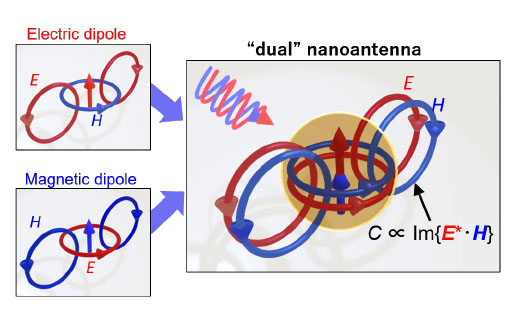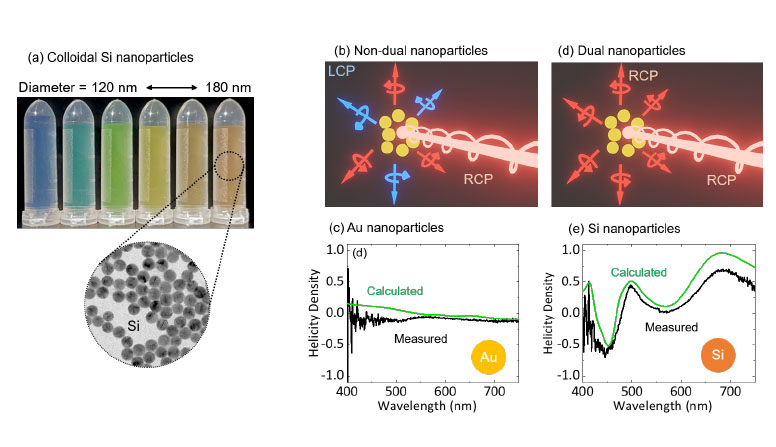| Jun 28, 2023 |
Scientists developed a spherical nano-antenna that forms a near field of circularly polarized light
(Nanowerk News) A research team from the Graduate School of Engineering at Kobe University, comprising of Master's student Hiromasa Negoro, Associate Professor Hiroshi Sugimoto, and Professor Minoru Fujii, have successfully innovated a spherical nano-antenna. This antenna can generate a near field of circularly polarized light, a significant development in the field of nanotechnology and molecular biology.
|
|
The team's findings were published in Nano Letters ("Helicity-Preserving Optical Metafluids").
|
 |
| Schematic of electric dipole, magnetic dipole and "dual" nanoantenna, (Image: SUGIMOTO Hiroshi)
|
|
The crux of their research revolved around addressing the current limitations of detecting and separating chiral molecules. Chiral molecules and their mirror-image isomers, known as enantiomers, exhibit distinct properties within living organisms.
|
|
While there are currently existing detection methods and photochemical reactions that utilize the differences in optical absorption for left and right circularly polarized light (circular dichroism) in these molecules, they are limited by requiring high sample concentrations and prolonged measurement times. This is largely due to the negligible difference in absorption. Nano-antennas that amplify electromagnetic fields have been proposed to overcome these limitations, but conventional models have struggled to maintain the circular polarization of the incoming light.
|
|
The Kobe University research group overcame this hurdle by proposing and testing a novel nano-antenna design. This design boosts electromagnetic fields while maintaining the circular polarization of incoming light. It achieved this by exploiting optical resonance, maintaining the circular polarization of the light across a broad spectrum using silicon nanoparticle colloids developed independently by the team.
|
|
This novel approach enhances the response of chiral molecules to circularly polarized light, making it a potentially transformative development for the sensitive detection of molecular chirality and asymmetric photochemical reactions. These techniques could find wide applications in biomolecule analysis, chemical substances, and pharmaceuticals.
|
 |
| (a) Photographs of colloidal Si nanoparticles in water with different diameters. (b, d) Schematics of scattering of circularly polarized light in "non-dual" (b) and "dual" (d) nanoparticles. (c, e) Calculated and measured helicity density spectra of Au (c) and Si (e) nanoparticles. (© Nano Letters)
|
|
In their study, the team focused on the Mie resonance of dielectric nanoparticles with a high refractive index. These particles can enhance both incident electric and magnetic fields, making them "dual" nano-antennas. The researchers demonstrated that these particles could preserve the helicity (handedness of circular polarization) of incident circularly polarized light under specific conditions, creating a near field of circularly polarized light.
|
|
The team independently developed a colloidal solution of crystalline silicon nanoparticles and used it to demonstrate this property. They successfully showed that "dual" nanoparticles satisfying specific conditions could preserve the scattered light helicity of the incident circularly polarized light. The researchers showed that the helicity conservation of incident circularly polarized light is possible in wavelengths of 550 to 750 nm, indicating the creation of a circularly polarized near field on the nanoparticle surface.
|
|
This development paves the way for enhanced interactions between light and chiral molecules, thereby improving the circular dichroism of chiral molecules. This could lead to more sensitive detection and analysis, increasing the efficiency of asymmetric photochemical reactions with potential applications in the pharmaceutical industry. Additionally, the novel nanoparticle solution developed by the team could serve as a groundbreaking new medium for light polarization control.
|


